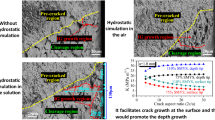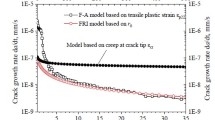Abstract
This paper is concerned with an accelerated testing and modeling of stress corrosion cracking (SCC) phenomena in pipe grade steels in near neutral pH environment. In modeling of SCC, the authors adopt the crack layer theory that provides formalism to account for contributions to crack growth rate such processes as electro-chemical corrosion, hydrogen embrittlement and mechanical loading. Special attention is paid to the hydrogen diffusion, a precursor to hydrogen embrittlement. The energy-momentum tensor (Eshelby's tensor) is employed to evaluate the thermodynamic forces responsible for SC crack growth. Griffith' crack equilibrium condition is used to derive a quasi-equilibrial SC crack growth equation. A parametric study and comparison with the experimental results of corrosion fatigue tests for various maximal stress, stress ratio and electric potential are performed to examine the validity of the proposed model.
Similar content being viewed by others
References
Volman, K.W., Cote-Verhaaf, A. and Iling, R. (1996), Public Inquiry Concerning Stress Corrosion Cracking on Canadian Oil and Gas Pipelines, National Energy Board Report of the Inquiry, MH-2-95.
Wei, R.P. and Landes, J.D. (1969), Mater. Res. and. Stand., 9(7), pp. 25-36.
Wei, R.P. and Gallaher, L. (1972), Corrosion Fatigue: Chemistry, Mechanics and Microstructure, NACE-2, Houston, TX, pp.396-408.
Austin, C.P. and Walker, J. (1972), Corrosion Fatigue: Chemistry, Mechanics and Microstructure, NACE-2, Houston, TX, pp.424-436.
Rhodes, D., Musuva, I.K. and Radon, I.C. (1981), Eng. Fract. Mech., 15(3), pp. 407-419.
Parkins, R.N. and Greenwall, B.S. (1977), Metal Sci., 11(8), pp. 405-413.
Zhang, B., Fan, J., Gogotsi, Y., Chudnovsky, A., & Teitsma, A. (2000), Theoretical and Experimental Study of Stress Corrosion Cracking of Pipeline steel in Near Neutral pH Environment, IPC2000, IPC00-0624.
Kadota K., Chudnovsky A. and Slojimirovic, A. (1992), An Equilibrium Process Zone in Polymeric Materials, Journal ofApplied Polymer Science, 46, pp. 1051-1056.
Lambert, S.B., Beavers, J.A., Delanty, B., Sutherby, R. and Plumtree, A. (2000), Mechanical Factors Affecting Stress Corrosion Crack Growth Rates in Buried Pipelines, IPC2000, 961-965
Chudnovsky, A. (1984), Crack Layer Theory, NASA Report, N174634, March.
Chudnovsky, A., Dunaevsky, V. A. and Khandogin, V. A. (1978), On the Quasi-Static Growth of Cracks, Archives ofMechanics, 30(2), pp. 165-174.
Eshelby, J. D. (1951), The Force on an Elastic Singularity, Phil. Trans. Roy. Soc. Lond., A244, pp. 87-112
Eshelby, J. D. (1970), Energy Relations and the Energy-Momentum Tensor in Continuum Mechanics, in Inelastic Behavior of Solids, eds. Kanninen, M.F. et al, New York, McGraw Hill, pp. 77-114
Pack, Y.E. and Hermann, G. (1986), Conservation Laws and the Material Momentum Tensor for the Elastic Dielectric, Int. J. Engng. Sci., 24, pp. 1365-1374.
Dascalu, C. and Maugin, G. A. (1994), Energy-release Rates and Path-independent Integrals in Electroelastic Crack Propagation, Int. J. Engng. Sci., 32, pp. 755-765
Author information
Authors and Affiliations
Rights and permissions
About this article
Cite this article
Choi, BH., Chudnovsky, A. Stress Corrosion Crack Growth in Pipe Grade Steels in Near Neutral pH Environment. International Journal of Fracture 116, 43–48 (2002). https://doi.org/10.1023/A:1022665831622
Issue Date:
DOI: https://doi.org/10.1023/A:1022665831622




